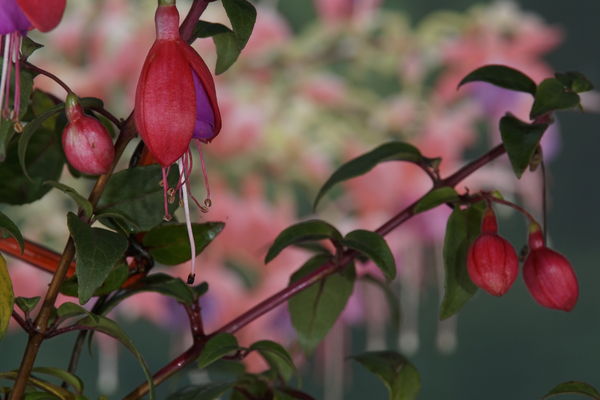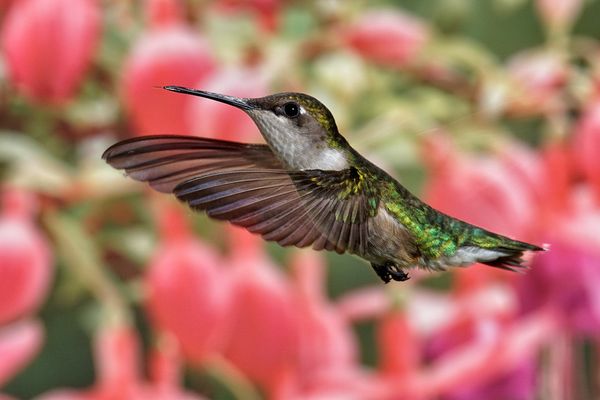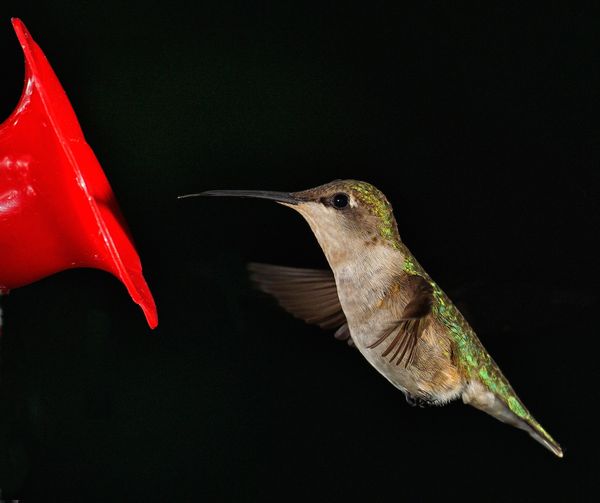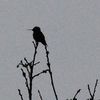Smooth light vs. harsh light
Aug 1, 2014 10:22:11 #
I'm continually modifying the process I use to make my hummingbird photos. Yesterday I tryed something new, diffusing the light from my flashes. I did not help!
I have attached a photo of my hummingbird trap and the two homemade diffusers I used. I also include a photo taken using the diffusers. While it may be a pleasing picture, the detail in flower petals is soft. Because I'm after showing all the detail in the birds feathers that I can, I concluded light diffusion is the wrong thing for me to be doing. I guess it's used in portrait work to hid wrinkles and blemishes.
I have attached a photo of my hummingbird trap and the two homemade diffusers I used. I also include a photo taken using the diffusers. While it may be a pleasing picture, the detail in flower petals is soft. Because I'm after showing all the detail in the birds feathers that I can, I concluded light diffusion is the wrong thing for me to be doing. I guess it's used in portrait work to hid wrinkles and blemishes.
Aug 1, 2014 10:31:09 #
Davethehiker wrote:
I'm continually modifying the process I use to mak... (show quote)
Very ingenious, nonetheless, Dave. Did you capture any shots of the hummers with that setup?
Aug 1, 2014 10:36:34 #
Papa Joe wrote:
Very ingenious, nonetheless, Dave. Did you capture any shots of the hummers with that setup?
Not any worth posting. If you look at my recent postings you will find many good photos of hummingbirds.
I just ordered four large canvas prints to be made for clients.
Aug 1, 2014 10:37:57 #
Davethehiker wrote:
Not any worth posting. If you look at my recent postings you will find many good photos of hummingbirds.
I just ordered four large canvas prints to be made for clients.
I just ordered four large canvas prints to be made for clients.
Yes Dave, I've seen and admired your past shots. Great work! I was just curious of the difference while using the diffusers.
Aug 1, 2014 10:40:15 #
Davethehiker wrote:
I'm continually modifying the process I use to mak... (show quote)
Shooting hummingbirds is dependent upon earning their trust so they become comfortable with you and your gear. When they reach a level of trust they will allow your presence with little or no reaction from them. The use of a flash is one of the best possible methods of chasing them away. Flash is invasive, especially to flying animals. When they see that flash they will assume the worse and flee instantly. To get the birds wings frozen in image you will have to learn how to shoot in natural light at very high shutter speeds, 1/4000 is guaranteed to work. People post photographs taken of hummers using flash and the wings are blurred! Initially, the wing will look stopped until the image is expanded, the wing is blurred. Get the real shot, work a little bit harder. Hummingbirds will let you get close, I had one hover in front of me while I was sitting at a table. It was almost surreal as it just hung in the air watching me. When it flew away I felt complimented, they now allow me into their world. This really does work, and the rewards are awesome. GL with your shooting of hummers. Please post your results, every bird is distinctly different.
Aug 1, 2014 10:50:51 #
Davethehiker wrote:
I'm continually modifying the process I use to mak... (show quote)
Ditto what davidrb said. Also try to arrange a smoother or less cluttered background. I adjusted the height of my feeders so that the background is distant trees.
I realize this is not always possible depending on location.
I also don't care if the wings are blurred in some instances--it gives a sense of motion and action. A lot of blur is preferable to a little.
In real life, you don't see hummer wings holding still...
Aug 1, 2014 10:57:32 #
davidrb wrote:
Shooting hummingbirds is dependent upon earning th... (show quote)
My experience with flashes has been different from yours. Yes they react to the flashes, but become accustomed to it. Just yesterday another hummer flew through the open window seen in the above photo. They are remarkably intelligent! While the flash duration is only on the order of 80 micro seconds, the bird was able to remember where each blast of light came from and flew up to each of my six flashes in a challenging manner, checked me out, then flew back out the window.
I can and have photographed hummingbirds with available light, and 1/8000 shutter speeds (HSS). I have had the most success using multiple strobes.
Yes, I could also take sharp photos of hummingbirds sitting still at a hummingbird feeder, with or without flash. I'm glad you like blurred wings, I strive to stop them.
I limit the detail on the photos I post here on UHH. The prints I sell look much better.
Aug 1, 2014 13:45:45 #
Davethehiker wrote:
My experience with flashes has been different from... (show quote)
Thanx for sharing this information. Your mentioning the birds ability to remember locations is very interesting. Are you using the camera to fire the strobe (s), or do you do it manually? Your photograph shows a rather close setting. Have you tried strobes in a more open environment? I agree with your assessment about SS is used to show the wings. The idea I try to capture isn't so much the wing tips themselves but the joint where the wing connects to the body. Since the bird can literally turn it's wings upside down while flying I like to show the position of that joint. To capture the wing inverted and extended forward is very difficult. Of the 1000's of shots I have there are less than 100 with the wings in that position. They are incredible little machines, scientists have been trying to figure out how and why for many years. I do not care why, just that I get to view them. Thanx again. :lol: :lol: :lol:
Aug 1, 2014 14:29:44 #
davidrb wrote:
Thanx for sharing this information. Your mentioni... (show quote)
This link explains my camera and flash gear:
http://friedmanarchives.com/~download/blog/DeBar%20Hummingbird%20Article.pdf
The above link is what I was doing about three years ago. I found using layers in PhotoShop a bit tedious, and some experienced photographers could tell what I was doing. I changed my technique so now a controlled background is photographed with the the bird at the same moment. So far I have not revealed to anyone how I do this. I'm holding a class at my home on the 23rd of this month where I'm going to demonstrate how I do this to some friends and my local camera club members. If you read the PDF file above you will understand the problems of mixing high speed photography and any kind of recognizable background.
I have hundreds of isolated hummingbird photos with their wings and bodies in all kinds of positions.
I'm getting off topic. I really would like to hear from people and their experience using diffused light vs. more "point" light sources. I suspect that diffused is more flattering but point light sources reveal better detail.
Aug 2, 2014 01:02:06 #
Dave I agree with you that the sharp details are what makes your shoots outstanding, the diffusion would lose some of that. And the setup scene allows you to get some great shots without having to get eye strain in PP. Actually I get a stiff neck, sore jaw muscles and a head ache from some of my PP work.
Davethehiker wrote:
This link explains my camera and flash gear: br ht... (show quote)
Aug 2, 2014 09:42:08 #
For those who prefer a "natural" or uncluttered background background, I wonder if they realize what the camera will give you if you don't take control of the background. I now provide a photo with the natural background of a motion stopping strobe used in broad daylight. I call it a "coal mine hummingbird."
Aug 2, 2014 16:45:47 #
Davethehiker wrote:
For those who prefer a "natural" or uncluttered background background, I wonder if they realize what the camera will give you if you don't take control of the background. I now provide a photo with the natural background of a motion stopping strobe used in broad daylight. I call it a "coal mine hummingbird."
Your hummingbird photos are beautiful. After one gains their trust, they will become very playful, and even pose for photos. They are extremely intelligent birds, and love spending time with people....I call them, "Dolphins of the sky." They are intelligent, love people, and are very playful.
Aug 2, 2014 18:24:38 #
Davethehiker wrote:
I'm continually modifying the process I use to mak... (show quote)
You might want to try a set-up with multiple flashes (used on the birds and on the background/s) A flash set at 1/64 or 1/128 power or even lower will freeze any motion sharply.
Aug 2, 2014 18:41:04 #
DominicsOwner wrote:
Your hummingbird photos are beautiful. After one gains their trust, they will become very playful, and even pose for photos. They are extremely intelligent birds, and love spending time with people....I call them, "Dolphins of the sky." They are intelligent, love people, and are very playful.
I totally agree with everything you said about them. They seem to have left and gone elsewhere. I have not seen them for a few days. It's been cool and rainy. I put out fresh sugar water and hope they return soon.
Aug 2, 2014 18:45:02 #
speters wrote:
You might want to try a set-up with multiple flashes (used on the birds and on the background/s) A flash set at 1/64 or 1/128 power or even lower will freeze any motion sharply.
Yep, that's what I have been doing (with the exception of the "coal mine") )photo. My Sony/Minolta flashes only go down to 1/32. Sony does not provide good specs on their flashes. I have no good idea how long a time period 1/32 relates to?
:?:
If you want to reply, then register here. Registration is free and your account is created instantly, so you can post right away.








